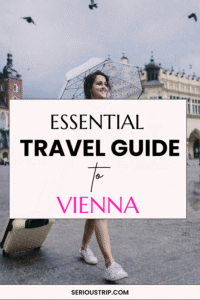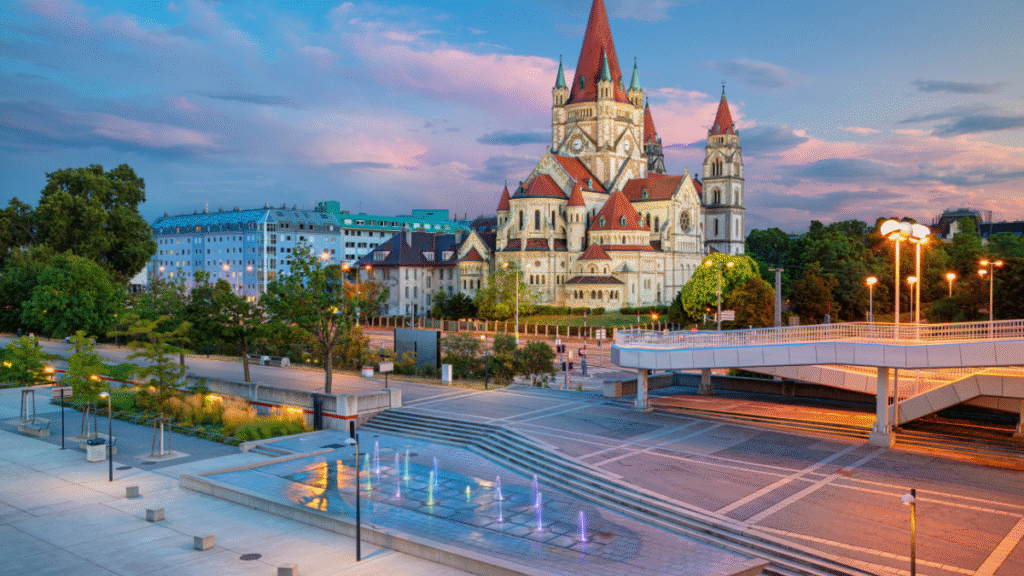The capital of Austria, Vienna has been called the cultural jewel of Europe as imperial tradition and present-day creativity co-exist with graceful ease. Whether it be the epic Gothic architecture of St. Stephen’s Cathedral, the rich history of the Habsburgs, the enlightened music of Mozart and Strauss or the colourful coffee house culture, Vienna is a city with an assurance of good taste in its every corner.You love art and music, classical music to be more exact, history and you just want to relax somewhere in Europe, then you will find what you are looking in Vienna. There is something unforgettable, something grand and eternal. This travel guide will be your companion to the discovery of Vienna in its fullest detail: when to go, how to travel within the city, what to visit on your way, where to eat and how to spend the most of your time in the capital of Austria, the city that never sleeps.
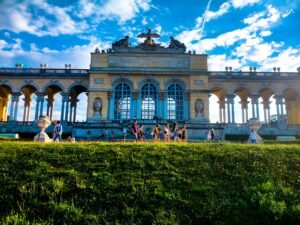
What are the reasons to visit Vienna?
1. Imperial History and Magnificent Construction
Vienna had been the capital of Austro-Hungarian Empire. Today, it is possible to walk through the palaces of the empires such as Schönbrunn and Hofburg, luxurious structures such as the State Opera Vienna, baroque gardens and churches, which help feel yourself in the past.
2. Capital of the world on Classical music
It is the capital of Mozart, Beethoven, Haydn, Schubert and Strauss. It is a very regular event and there are equally a lot of concert venues in Budapest like Musikverein and Vienna State Opera to mention but a few to give the music lover a second to none experience.
3. Golden-standard Museums and Art
With its collection of masterworks by Klimt, Schiele, Rembrandt and others, Vienna is packed with galleries and museums housed in ornate buildings: the Belvedere, the Kunsthistorisches Museum, the MuseumsQuartier.
4. Cuisine Culture and Café
Viennese coffee houses are in themselves institutions. Place an order of a mélange, take some slice of sachertorte and be carried away admiring the Old World charms of such a place like Café Central or Demel. The Austrian food is rich and comforting, so Wiener Schnitzel, goulash, and apple strudel might come to your mind.
5. Liveability and Green Spaces
Vienna is ranked among the most livable cities in the world with green parks such as the Stadtpark and Prater, banks of rivers and relaxed tempo that easily lends itself to urban style.
Traveler Information on When to Visit Vienna
Spring (March – May)
Spring is the time when Vienna wakes up of cold and starts blossoming. Other gardens are exemplary in Schönbrunn and Belvedere. The crowds of tourists are moderate and weather is pleasant.
Summer (June – August)
Summer is a busy time in Vienna, as it is warm and there are long light hours and a full, rich cultural calendar. But then, it is also tourist season. You will have to pay more and attractions will be crowded.
Autumn (September – November)
It may be the most appropriate time of the year to visit. The autumn leaves in urban parks, the good weather conditions and reduced number of visitors makes it favorable to do the sightseeing and café-hopping.
Winter (December – February)
It is charming in Vienna at winter. The city is illuminated with Christmas markets and a Stadt im Schnee effect has been created when the city is dusted with snow making it look like a postcard picture. It is opera season too and museum time.
Access and Transport in Vienna
By Air
Vienna International Airport (VIE) is closely connected to the capitals of the entire world. The City Airport Train (CAT), the S-Bahn or local buses, and taxis are possible to get to the city centre within 15–30 minutes (depending on the destination).
By Train
Vienna Hauptbahnhof – A big European rail hub. You can reach up quickly and comfortably either via Munich, Prague, Budapest and other big cities.
On the Bus or By Car
There is a network of international operators such as FlixBus which have routes to and within Vienna. In case you come by car, pay attention that parking in the center of the city may be restricted and rather costly.
How to Move Around the City
Vienna public transport is convenient and fast. All the corners of the city are linked by the U-Bahn (subway), trams and buses.
Buy a Vienna City Card or 24 / 48 / 72 uses public transport ticket and you can use it unlimited times.
Walking is strongly recommended; most of the major attractions are within walking distance.
Biking is also fashionable during warm weather, and a few places to rent bikes are available.
Vienna Accommodation – Where to Stay in Vienna
1st District
The old city of Vienna, including the St. Stephen Cathedral, the Hofburg and fancy hotels. The ideal accommodation option is that young people just arriving for the first time and who would feel close to all the activities.
Leopoldstadt (2nd District)
This neighborhood is found between the Danube Canal and the Danube River, has lots of green space such as Prater and is more family friendly, less and cheaper.
Neubau (7th District)
It is the hipster and artsy district of Vienna, with MuseumsQuartier, indie shop, and cool cafes. Perfect place to stay is good for young travellers or artists.
Mariahilf (6th District)
Perfect to do shopping, Mariahilferstrasse in particular. It is well accessible through metro and adjacent to inner city.
Landstraße (3rd District)
A residential district and well connected to Belvedere Palace and Metro stations of the Wien Mitte transport hub.
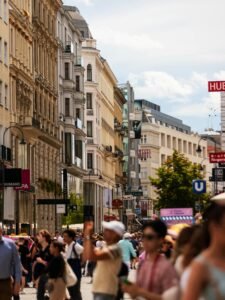
Gems of Vienna That You Have To See
-
Schönbrunn Palace – The ex-Habsburg summer palace with unmatched interiors, vast gardens, Gloriette terrace, and Tiergarten zoo.
-
Hofburg Palace – Central city winter residence of Habsburgs with Spanish Riding School, Sisi Museum, and Imperial apartments.
-
St. Stephen’s Cathedral (Stephansdom) – Gothic wonder with a climbable south tower and underground catacombs.
-
Belvedere Palace – Baroque architecture turned museum, home to Klimt’s The Kiss.
-
MuseumsQuartier – Leopold Museum, MUMOK, cultural hubs, and cafés.
-
Vienna State Opera – Guided tours or opera nights with available standing-room tickets.
-
Albertina Museum and Art Gallery – Home to vast print collections and exhibitions.
-
Prater and Giant Ferris Wheel – Historic amusement park and panoramic Ferris wheel views.
-
Karlskirche (St. Charles Church) – A baroque masterpiece with an elevator into the dome for fresco viewing.
-
Naschmarkt – The most famous food market for local and international cuisine.
Viennese Food and Drink
Foods You Cannot Miss:
-
Wiener Schnitzel – Breaded and deep-fried veal or pork cutlet with sides.
-
Tafelspitz – Boiled beef with horseradish, applesauce, and root vegetables.
-
Apfelstrudel – Flaky pastry with cinnamon, sugar, and raisins.
-
Sachertorte – Rich chocolate cake with apricot jam.
-
Kaiserschmarrn – Shredded pancakes with powdered sugar and plum compote.
Café Culture:
Perfect for mornings or relaxing afternoons.
Try: mélange, Einspänner, or verlängerter.
Notable cafés:
-
Café Central
-
Demel
-
Grand Café Sperl
-
Café Hawelka
Drinks We Recommend:
-
Austrian wine (Grüner Veltliner, Riesling, Blaufränkisch)
-
Local beers
-
Almdudler herbal soda
-
Aperol Spritz in summer
Nightlife and Culture
Live Music and Concerts
Attend opera at Vienna State Opera or orchestra concerts at the Musikverein.
Bars and Nightclubs
Check out rooftop views at Das LOFT or underground vibes at Grelle Forelle.
Cabaret and Theater
Volkstheater and Burgtheater for plays; Simpl for cabaret-style shows.
Film and Literature
Visit Literaturhaus Wien or Shakespeare & Company for literary events.
Day Outings from Vienna
-
Wachau Valley – Vineyards, towns like Dürnstein, and the Danube – great for wine.
-
Bratislava, Slovakia – Charming old town just one hour away.
-
Salzburg – Mozart’s birthplace and The Sound of Music backdrop.
-
Wienerwald (Vienna Woods) – Hiking, monasteries, and scenic views.
-
Laxenburg Castle and Park – Romantic lakeside palace park just outside the city.
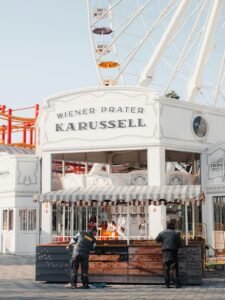
Sample 5-Day Itinerary
1:
-
Morning: Discover Innere Stadt, St. Stephen’s Cathedral
-
Afternoon: Hofburg Palace and Spanish Riding School
-
Evening: Graben and Kohlmarkt, dinner at Plachutta
2:
-
Morning: Schönbrunn Palace and Garden
-
Afternoon: Tiergarten Zoo or carriage ride
-
Evening: Opera performance
3:
-
Morning: Belvedere Palace, The Kiss
-
Afternoon: MuseumsQuartier (Leopold and MUMOK)
-
Evening: Naschmarkt dinner and drinks
4:
-
Day trip to Wachau Valley or Bratislava
-
Evening: Wine tasting or traditional Heuriger
5:
-
Morning: Café Central, Albertina Museum
-
Afternoon: Relax at Stadtpark, see Strauss monument
-
Evening: Rooftop bar or Danube river cruise
Good Advice to Visit Vienna
-
Language: German is the official language. English is widely spoken in tourist areas.
-
Currency: Euro. Cards accepted nearly everywhere, though cash is useful.
-
Safety: Vienna is very safe. Use general common sense.
-
Tipping: Round up or leave 5–10% if service charge isn’t included.
-
Dress Code: Austrians dress well, especially for cultural events.
Final Thoughts
As a city Vienna is not only one which displays history but also permeates it. It is a point where art and music and imperial magnificence merges with everyday life in timely choreography of grace. Whether you are visiting in the gardens of palaces, soaking in scrumptious slice of cake under chandeliers or hearing Mozart concerto in the concert hall where he played it a long time ago Vienna has so many things to make your trip memorable even long after returning.
Visit, not in order to pass by, but to enjoy. The city of Vienna pays off patience and curiosity and the desire to sit down and to have the century talk to you.
Save pin for later
